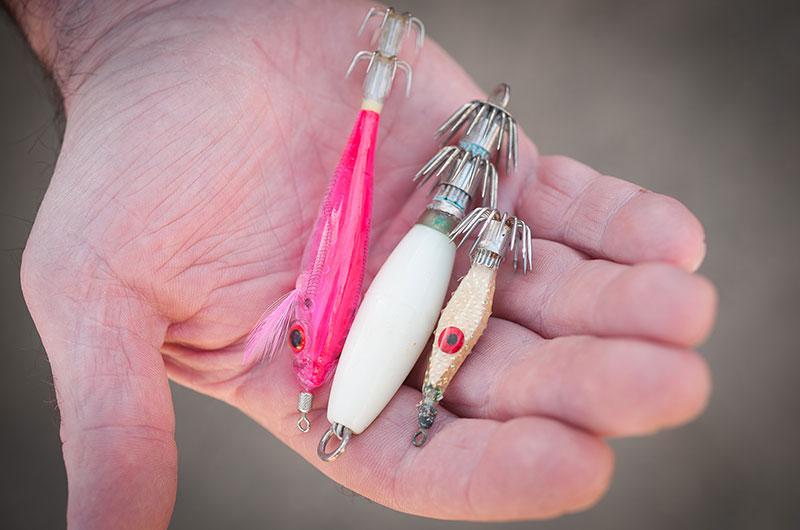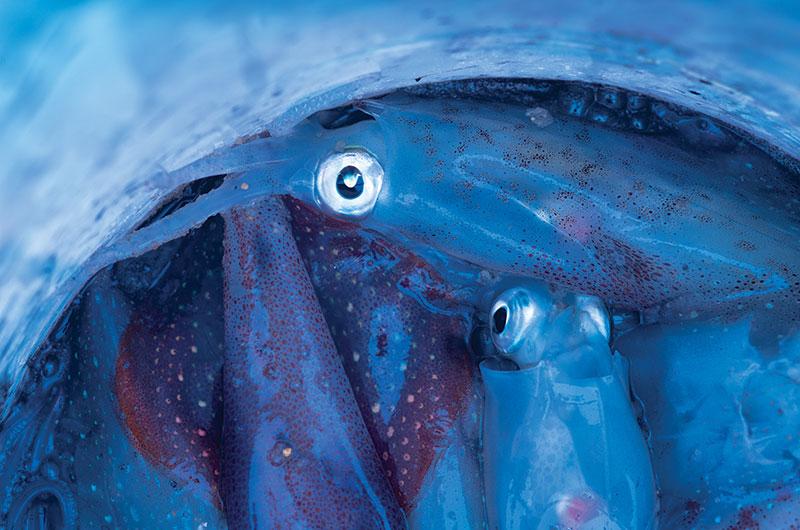Last spring, toward the end of May, I got a fishing call. Squid had been showing up at Bend in the Road Beach in Edgartown. That evening just before sunset, I grabbed two lightweight bonito rods, a bucket, a few squid jigs, and my thirteen-year-old son.

You don’t often catch squid from the beach like you do bluefish or stripers, but last year they were schooling offshore just waiting to be caught. Word spread quickly. By the time I arrived, there was a line of people at water’s edge casting and catching. Unlike the typical squid jigging on the docks, along a beach you can spread out at comfortable distances.
The evening didn’t disappoint. In fact, it was one of those awesome Vineyard experiences. The night was warm and still, the sun was setting in its myriad colors, there was lots of laughter, and buckets were filling up.
It was only the second time my son, James, had fished for squid, but he was bringing one in with every cast. And that is the beauty of fishing for squid. You don’t need a boat, fancy equipment, or years of fishing experience. You don’t even need live bait on a hook.
I happen to love it because it hits my Vineyard trifecta: It results in free food, takes me out into nature, and it’s fun.
Squid are so odd-looking, not particularly fish-like, but almost beautiful in all their shimmering translucence. Their skin is covered in thousands of light-reflecting cells that can quickly change into multiple colors. It’s a concealment tool in their arsenal, employing camouflage. They are better known for squirting black ink – which often happens somewhere between leaving the water and being swung into the bucket. Under the water, squid use this ploy to create a dark cloud around themselves to dodge and deceive a predator.

During their short lives – averaging six months – squid show up in Vineyard waters each spring to spawn. Their arrival is often a big deal because it signals the start of the fishing season on the Island, explains Mark Alan Lovewell, fishing columnist for the Vineyard Gazette. “It’s like daffodils on the waterfront,” he says. “Squid bring...all the predators. It’s a feeding frenzy when the squid arrive.” In fact, most people fish for squid not so much for food to eat themselves, but as food for fish – bait.
Squid swim in schools, coming and going throughout the summer, sometimes into fall. “It was a good year for squid fishermen last year,” says Mark. “They’ve had years that haven’t been so good.” In fact, scientists say that squid numbers, like so many other ocean fish, are declining.
Our last squid expedition of the season, toward the end of October, found us on the docks in Edgartown – a more typical location. We brought Tom, our newly arrived exchange student from England. Fishing, he said, was a hobby back home, and we thought this might be a quintessential Vineyard experience from which he could bring back memories. Plus we could make a quick tour of Edgartown’s shops and streets, stately whaling captain’s houses, and beautiful gardens.
We walked over to Edgartown Marine. We weren’t having any luck there either. But one older teenager perched on the dock kept knocking them back, one after another. I whispered, “Watch him,” and we tried to emulate. But whatever his technique, a smooth, expert motion obviously born of years of practice, it could not be easily duplicated.We saw about eight or nine people squid fishing between the Edgartown Yacht Club and the Atlantic Fish & ChopHouse. As we found our spots, we noticed very few had squid in their buckets. We dropped our lines and started jigging, lifting the rod up and down with a few short jerks to get the squids’ attention. We all felt nibbles, but it seemed as soon as someone announced they had one on the line, it inevitably came off. Before we gave up and left empty-handed, we tried one more spot.
Luckily, Tom did manage to catch one squid, the only one of us who did. So while we were disappointed, he would at least be able to tell his friends in England about the giant squid he caught in America.
Squid 101
Equipment needed: a rod, squid jigs, weights, a bucket to hold your catch, and clothes you don’t mind getting stained with black ink.
Also bring: your kids.
Squid jigs: Available at Island tackle shops, lures specific for squid typically cost less than $10. Make sure the jig is heavy enough to sink fairly quickly if you’ll be jigging – though you can add some weights to the line if need be. My friend Amy swears by the pink-colored jigs, which I thought was funny until I noticed online discussion about which colors work best, and others agree with her (www.squidfish.net is a good resource).
Time of the year: late spring into summer, and sometimes till October.
Most popular spots to catch squid: Memorial Wharf in Edgartown, and other docks in Edgartown and Menemsha – near bright lights, which attract squid.
Times to go: Evenings after sunset, from about 7 to 10 p.m., and early morning from 6 to 9 a.m.
Permits and limits: A saltwater fishing permit is required and available through the Massachusetts Division of Marine Fisheries by phone or online (866-703-1925, www.mass.gov/dfwele/dmf). The permit costs $10 for ages 16 to 59, and is free for 60 and older. There are no catch or size limits.
Storage: Clean and refrigerate for a day or two, or put whole squid in sturdy plastic bags and freeze.
How to clean squid
It’s a bit messy, but not hard. Of the many short clips you can watch on the Internet, the best I’ve seen is on this instructional cooking site: www.how2heroes.com. Search “how to clean squid.”
To start, gently pull the head away from the body. As you do, the entrails should come out. If not, remove any remaining with your fingers. Reserve the tentacles by cutting next to the eyes, and discard the rest.
If the ink sac is intact when the entrails come out and you would like to keep some ink for cooking or coloring homemade pasta, simply puncture the small sac and reserve the ink. Some people mix it with a little water or vinegar to help preserve it.
Inside the body is a long, thin piece of cuttlebone. You should be able to grasp the top of it; gently pull to remove and discard. (It looks like a transparent quill pen.) The outer colored skin can be rubbed or scraped off, and the fins can be cut or gently pulled off, leaving a perfectly long, white tube. Rinse well under running water.
To clean the tentacles, feel in the center for a hard beak that can be pushed out and discarded.
Basics of cooking squid
Fresh squid (often called calamari, its Italian name) is delicious – pure and sweet, like the sea. It’s a near-perfect protein, with very little fat.
Once you have cleaned the squid, you can cut the body into rings, or keep it whole to stuff or grill or make into a cutlet. The biggest complaint about squid or calamari is its tendency toward chewiness. The key to preventing this is to cook quickly at a medium-high to high temperature.
Here are some easy cooking ideas:
• Cut into rings and sauté in hot olive oil; it can take less than 2 to 3 minutes to cook. Add to a paella or pasta with a cream sauce or a tomato sauce with fresh herbs, olives, and capers.
• Brush with oil and grill on both sides; it will cook in 2 to 4 minutes. Serve with a favorite salsa.
• Batter and deep-fry for 1 to 2 minutes. It’s good served with a flavorful dip.
Try these recipes:
Crispy Cutlet and Lemon Dressing








